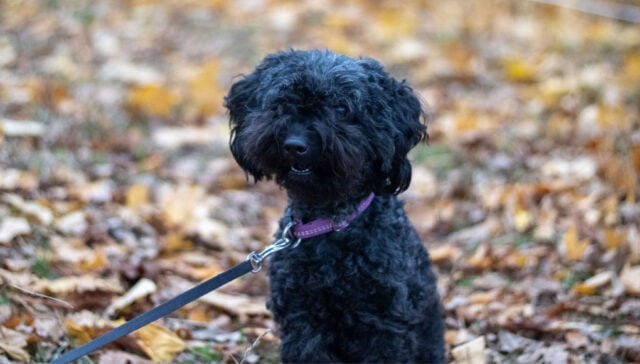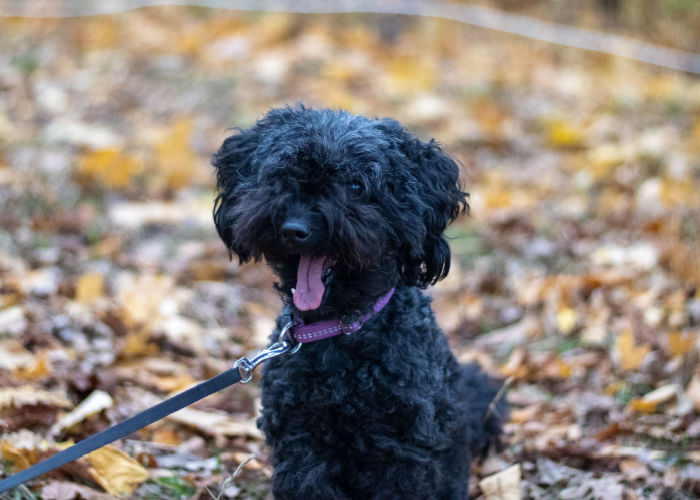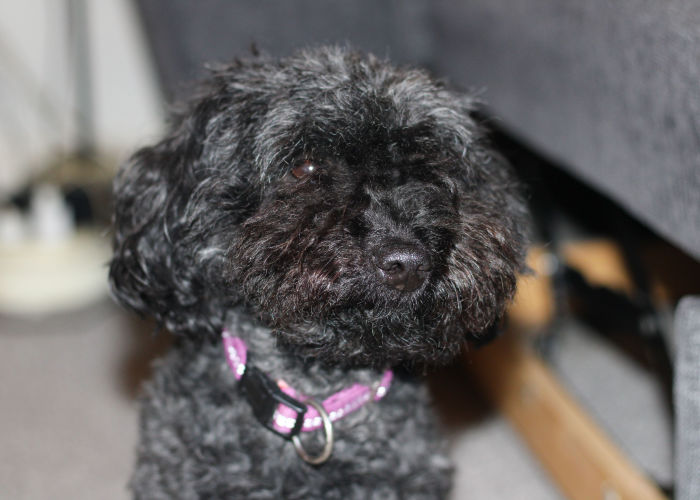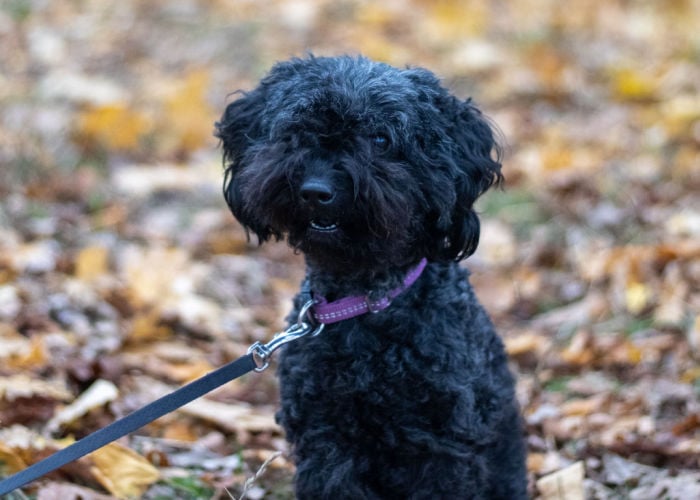
Table of Contents
- Jack-a-Poo Overview
- Jack-a-Poo Appearance
- Temperament of a Jack-a-Poo
- Jack-a-Poo and Barking: How Vocal Are They?
- Jack-a-Poo Health
- Jack-A-Poo Care 101: The Best Practices for Your Spirited Companion
- Would You Be the Perfect Owner of a Jackapoo: Questions To Ask Yourself Before Adoption
- Do you live an active and energetic lifestyle?
- Does your everyday schedule allow you to shower a pet with quality time and attention?
- Do you have the patience and perseverance for consistent training?
- Do you have the time and finances to keep a Jack-a-Poo?
- Do you have any prior experience with small-sized dogs?
- Jack-A-Poo Dog Breed: Key Takeaways
Have you ever wondered what a mix between the fearless Jack Russel Terrier and a gentle Poodle would be like?
Introducing: the crossbreed between them, known as Jack-a-Poo.
If you’re looking for a cute, cuddly puppy with a wavy to curly-haired coat and a compact and well-proportioned body structure, you might find the Jack-a-Poo a suitable choice.
They are playful, affectionate, and energetic and can enliven any place with their friendly and sociable nature.
In this blog, we’ll discuss one of the most fundamental questions most people ask about this alert breed:
- General physical appearance
- Temperament and their vocal level
- Health and pet care needs
- Questions you need to self-reflect on before choosing Jack-a-Poo as your chosen breed
So, without further ado, let’s get started!
Jack-a-Poo Overview
The Jack-a-Poo is an upbeat mixed breed dog between the Jack Russel Terrier and Poodle.
In most cases, a Jack Russel is bred with a miniature or toy Poodle instead of the standard one.
This mixed breed is a great addition to your family because of their temperament, intelligence, and trainability.
They have several names and are sometimes affectionately called as Jack-a-Poodle, Poojack, Jackpoo, Jack-a-Doodle, Jackapoo, or Jackdoodle.
Not only are Jack-a-Poos desirable for their personality, but these designer breeds are best known for their size and adorable looks!

Jack-a-Poo Appearance
In general, a Jack-a-Poo can grow from 10 to 16 inches in height for both male and female dogs. They weigh around 13 to 25 pounds.
Just like their parents, their coat colors may vary, including black, gray, white, brown, and blue, or simply a mix of these.
You'll find their nose color black and their eyes color brown.
Temperament of a Jack-a-Poo
The personality of a Jack-a-Poo is a combination of its parent dogs. They are energetic, curious, intelligent, friendly, and a little mischievous.
With that said, they can be great mixed-breed dogs for your family and kids. They do well with children of their friendly nature.
However, just like with any other dog breed, you must always supervise your children when they're with your dogs.
On the contrary, Jackdoodles may take some time to get along with other pets and small animals.
They possess hunter instincts from the parent genes, which explains their tendency to chase smaller animals.
For first-time dog owners, this urge may be difficult to control at first.
They may also be quite protective and bark at strangers or uncommon factors.
They also have the tendency to dig a hole. So expect them to be digging once they get outdoors.
Jackapoos are known for being a furball of energy and may need at least 30 to 60 minutes of exercise daily.
As mentioned, they are an intelligent mixed breed. However, because of this, they tend to be stubborn.
Training them might be challenging, but with a little patience and hard work, you can teach them new tricks.

Jack-a-Poo and Barking: How Vocal Are They?
Due to its genetic predisposition, Jack-a-Poo, a crossbreed between Jack Russel Terrier and Poodle, may tend to bark greater than average.
Since both parent breeds are known for their alert and vocal behavior, the active Jack-a-Poo may exhibit similar behavior as an inheritance.
Still, it is worth noting that barking levels are not traceable to the transmission of genes only.
There are multiple social, cognitive, and behavioral factors at play here.
For example, a dog not socialized properly may learn to bark as a coping mechanism when exposed to unfamiliar people, animals, and surroundings.
It may also be excessively vocal to divert its owner’s focus to something important.
Since Jack-a-Poo is an active dog, it may be a source of outlet due to a lack of physical and mental stimulation.
Here, providing them with ample exercise may assist them in alleviating anxiety and boredom, resolving the issue.
Some dogs may also bark because their hunger and thirst needs are not fulfilled.
In addition, if you get an adult Jack-a-Poo, it may have the habit of barking loudly and excessively because its previous owners did not rectify the behavior from the start.
Apart from the biological factor, almost all factors are easily solvable.
Through consistent socialization, training, and positive reinforcement, every dog can be conditioned to become the good little boy he is.
Jack-a-Poo Health
The Jack-a-Poo mixed breed is a generally healthy breed.
However, due to their parent dogs, they may be susceptible to certain health issues.
But don't worry—these are mild and rare cases for your mixed breed.
The common health diseases your Jack-a-Poo could inherit are the following:
- Patellar luxation
- Addison’s disease
- Epilepsy
- Bloating
- Hip dysplasia
- Von Willebrand’s disease
- Cushing’s disease
- Hypothyroidism
- Skin disorders
There are instances when you can't avoid these genetic illnesses from occurring, but you can always lower the chances by giving your pooch the proper diet and exercise.

Jack-A-Poo Care 101: The Best Practices for Your Spirited Companion
Adopting a dog is a challenging task. You need to look at potential breeds that may be compatible with your lifestyle, research their temperament, and if they would be in sync with yours.
Fortunately, the Jackadoodle is a generally healthy mixed breed and can live from 12 to 15 years.
Still, it pays to give them the extra care and attention they deserve.
Additionally, understanding how to care for the breed you’re getting is equally important for your dog-parent dynamic and journey.
Decoding the Diverse Care Needs of Dogs
“Aren’t all dogs taken care of the same way, though?” is a question most prospective dog owners have while searching for a canine companion.
And, to answer that question, no, not really.
Each dog type has a distinct biological and psychological makeup that creates a variation in its needs.
For example, some dog breeds are regarded as more active and vocal than others. In contrast, some are quiet and love a soft cuddle session with their owners.
Some breeds, such as Basset Hounds, English Bulldogs, and Great Danes, are known for their calm and laid-back nature.
On the opposite end of the spectrum, we have an energetic, lively, and curious Jack-a-Poo who loves playing with their owners and exploring the world beyond their immediate home and fence.
Nurturing the Jack-a-Poo
The well-kept the dog, the better it would be physically and emotionally.
Here, we have created a list of everything you need to know about the affectionate and social Jack-a-Poo to assist you in your dog-enthusiast journey.
This will help you decide if this breed would be a suitable match for you (for potential owners) or enable you to take holistic care of one if you’re already an owner.
So, without further ado, let’s get started!
Exercise
The level of exercise a dog requires depends on their size, weight, temperament, etc.
Since Jack-a-Poos are small to medium-sized active dogs, they’d need daily physical stimulation to relieve their energy.
This will assist in keeping them engaged and prevent boredom and frustration from developing into destructive behaviors.
For this reason, we recommend a daily exercise lasting between 30 minutes to 1 hour.
You may divide it into multiple sessions per your schedule and your pet’s stamina.
So, get your furry friend and go on a nice long walk. Alternatively, you may head to an exciting off-leash park for fun, games, and excitement.
Training
Jack-a-poos are stubborn and intelligent, which may make them slightly challenging for novice owners.
Yet, at the same time, they’re affectionate and eager to please, which makes them ideal for most people looking for an active and vigilant furry friend.
Two integral factors significantly impact the trainability levels of a Jack-a-Poo.
Firstly, they need to be socialized from a young age.
Secondly, they need positive reinforcement from the start to form good habits.
This requires time, patience, and consistency, but the journey will be worth it, and the results will be rewarding!
Grooming
Jack-a-Poos have diverse coats, ranging from straight, wavy, and curly.
Some may inherit a hypoallergenic coat from their Poodle parent, while others may have a mixed coat from both parents.
Since there is no fixed idea here, the haircare and grooming of a Jack-a-Poo may depend on the coat type and desired length.
Brushing your pet's coat 2-3 times a week and bathing them every 4-8 weeks may help keep their hair and scalp healthy and nourished.
In addition, you may trim its nails every 4-6 weeks (or as frequently or rarely) as required, depending on nail growth and the activity level of your canine companion.
Lastly, ensure you brush your pet's teeth daily or at least several times a week to ensure a well-groomed and lovely appearance.
Diet and Nutrition
A nutritious diet is essential for maintaining a healthy weight balance.
You may look for high-quality commercial dog food specifically formulated for small to medium-sized breeds.
We recommend looking for meat as the primary component in the ingredient list and avoiding ones that contain unnecessary additives and artificial substances.
It is worth noting that small-sized dogs are susceptible to easy weight gain.
You’d have to be mindful of the portion quantity with food and any additional treats you may use during training.
We recommend sticking to homemade training treats. The natural ingredients would be nourishing and assist in sustaining weight instead of increasing it.
Socialization
Early socialization during puppyhood is essential for Jack-a-Poo's optimum growth and development.
Potential owners need to consider their affectionate, friendly, and social temperament.
They would be most suited to individuals with the time and patience to take them out on their daily walks.
It is important to remember that Jack-a-Poos have predatory instincts, owing to the hunting backgrounds of both their parents.
They may chase and run away after an object or animal while on walks.
Again, the ideal owner would be highly vigilant in ensuring the Jack-a-Poo is leashed and controllable in public to reduce potential accidents, etc.

Would You Be the Perfect Owner of a Jackapoo: Questions To Ask Yourself Before Adoption
You might be the perfect dog enthusiast, but that doesn't mean you'd be the ideal owner of a Jack-a-poo.
Fortunately, there are multiple dog breeds for everyone, which means no one has to be deprived of this adoring animal's love, companionship, and protectiveness.
In this section, we'll pose questions you need to ask yourself before choosing Jack-a-Poo as the breed you want to adopt.
The questions will be immediately followed by what the most suitable owner would be like for them. Let's dive right in!
Do you live an active and energetic lifestyle?
Jack-a-poos need everyday exercise and socialization to relieve boredom, stress, and curiosity.
They are lively and tireless and love spending their time on physically and mentally stimulating activities.
The ideal owner of a Jack-a-poo would be one with the time and zest to take their four-legged friend to the world beyond their home.
They may go for a much-needed walk, have a fun fetch-game session, or explore the wonders of spring as the season arrives!
Be mindful of springtime allergies, though, and take necessary precautions as required.
Does your everyday schedule allow you to shower a pet with quality time and attention?
Your pet will be like a baby that needs attention, love, and care to thrive.
Some people may need more time out of their schedule to devote to time-consuming activities such as pet care.
In that case, they may not be the perfect fit for a Jack-a-poo who needs someone to look after them.
They might also be susceptible to separation anxiety if left alone for too long.
This may manifest as other destructive behaviors such as excessive chewing, scratching or clawing, and even defecating or urinating indoors.
The ideal owner of a Jack-a-Poo would have the time out of their schedule to cuddle and play with their small-sized happy to acquire a harmonious pet-parent dynamic.

Do you have the patience and perseverance for consistent training?
Training any dog can be difficult, but it can be even more challenging if the breed has stubborn tendencies.
Such is the case for the intelligent Jack-a-Poo as well. They’re brilliant, making them considerably fast learners.
Yet, at the same time, they need a patient and persevering owner that can cater to their needs and not get restless when things don’t go according to plan.
This may include using operant conditioning through rewards (specifically treats) to build healthy habits.
Again, the ideal owner would be one who can take time out of their busy schedule and be determined to excel with their canine companion.
Do you have the time and finances to keep a Jack-a-Poo?
Adopting a pet requires considerable time and finances for healthy living.
These may include the initial cost of getting one, which may vary depending on who you’re getting it from.
A shelter may charge small, but it may be relatively costly if you get one from a Jack-a-Poo.
Apart from the initial cost, food and grooming needs are essential.
It is important to remember that Jack-a-Poos generally have a wavy or curly coat, which may be challenging to maintain.
It may necessitate visiting a professional groomer, posing additional charges.
Consider investing in good quality dog toys to keep your active Jack-a-Poo busy, or prepare emergency health funds for if they get sick, etc.
Do you have any prior experience with small-sized dogs?
Jack-a-Poos are generally small-sized dogs that exhibit distinct temperaments.
They’re soft, cuddly, affectionate, alert, energetic, and lively.
This differs from their large-sized counterparts, which may be gentler and more protective.
Of course, both sizes have varied personality differences, but that is a generalization most people assume to be true.
Having experience with small-sized dogs will give you an edge over those that don’t.
This means you already have a mental image that may not need much relative changing.
But even if the last question doesn’t sound like you, you can still proceed if the rest of the points resonate.
There’s a first time for everything, right?
It may seem daunting initially, but getting an adorable Jack-a-Poo may be rewarding once you go further in your pet parent journey!
Jack-A-Poo Dog Breed: Key Takeaways
Dogs make wonderful companions.
They’re affectionate and cuddly and can be a great source of emotional and social needs.
The Jack-a-Poo, with its high energy levels, will be a suitable furry friend for anyone that loves going on walks and playing and thrives off physically and mentally stimulating activities.
At the same time, social anxiety and the finances needed may be a concern for some people.
In this case, we suggest moving onto relatively low-maintenance dogs such as Chihuahuas, Dachshunds, or Pugs, etc.
These breeds are regarded as laid-back and don’t demand too much time.
This may be more suitable for people who have other priorities at the time but still want to feel the comfort of a furry friend to come home to.
Know more about these purebred dog breeds in the next articles!












